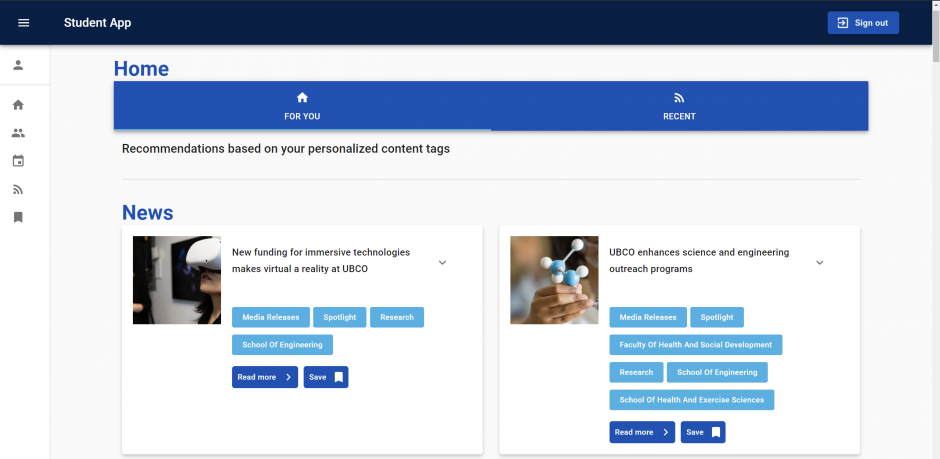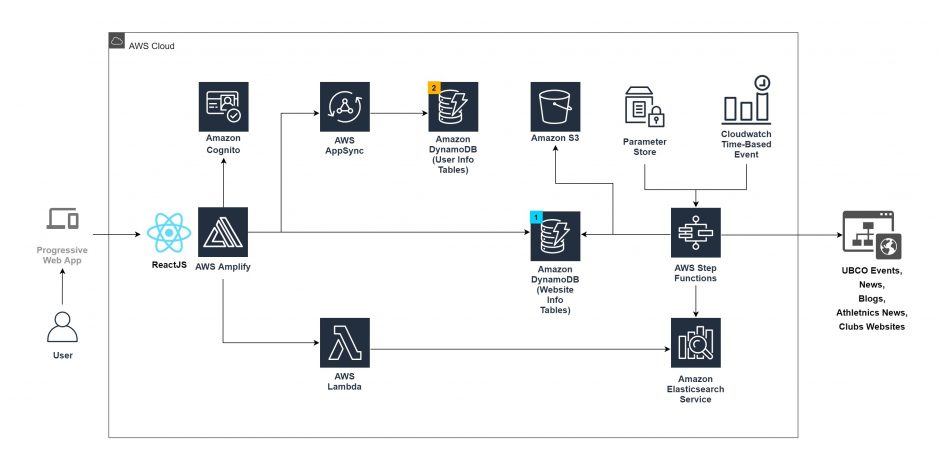UBC Okanagan: Student Connect Application
The University of British Columbia Okanagan (UBCO) builds a prototype that can connect first-year university students to their preferred activities, clubs, and campus news feeds, tailored to each student’s interest.
Today first-year university students are often overwhelmed by information overload, adding to the challenge of adapting and connecting at UBC. Large volumes of information and scattered information sources can create a barrier to engagement and connection. Student Affairs and IT Services at UBC Okanagan have teamed up in partnership with the UBC Cloud Innovation Centre (UBC CIC) and have developed a proof of concept (PoC) web application which personalizes information about UBCO events, student life, and clubs according to individual preferences based on responses to a questionnaire.
The PoC pulls information from many sources, including the UBCO Events page, UBCO student life blogs, UBC Students Union Okanagan Clubs and presents the information in a personalized dashboard.
Approach
The solution works by asking students to fill out a questionnaire about their interests and content preferences. The application then uses the information provided by each student to present personalized information that corresponds to their interest in campus activities, events, and UBCO news. The platform gives each student the ability to change their preferences anytime and allows the users to choose what information they want allowing them to control their level of engagement.

Different types of content recommended to them based on interests
Supporting Artifacts
Architecture Diagram

Technical Details
This prototype builds a centralised data aggregation and recommendation platform of relevant events, clubs and articles for students according to their interests. Users sign up using a secured login through Amazon Cognito into a ReactJS Progressive Web Application hosted via AWS Amplify (through desktop or mobile) and answer a one-time survey to identify their interests as category tags and demographic information.
The backend uses AWS Lambda functions orchestrated with AWS Step Functions to collect data from various categorised data sources, and persist them into:
Amazon DynamoDB (marked with blue 1 on the diagram) – for viewing all content from a specific data source such as the events, news, etc.
Amazon Elasticsearch Service – to query specific website data (events, news, etc) from using the interests students marked as their subscribed category tags
Amazon S3 – Website data (events, news etc) is saved into an S3 for the long term so that any future analytics chains can be built on top of it in a Data Lake architecture
Link to solution on GitHub: https://github.com/UBC-CIC/Student-Connect-App
About the University of British Columbia Cloud Innovation Centre (UBC CIC)
The UBC CIC is a public-private collaboration between UBC and Amazon Web Services (AWS). A CIC identifies digital transformation challenges, the problems or opportunities that matter to the community, and provides subject matter expertise and CIC leadership.
Using Amazon’s innovation methodology, dedicated UBC and AWS CIC staff work with students, staff and faculty, as well as community, government or not-for-profit organizations to define challenges, to engage with subject matter experts, to identify a solution, and to build a Proof of Concept (PoC). Through co-op and work-integrated learning, students also have an opportunity to learn new skills which they will later be able to apply in the workforce.

